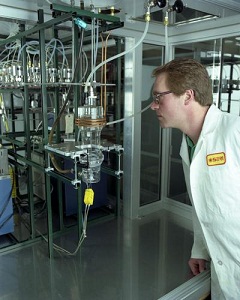Alta Devices' new thin-film PV reaching 28.2 percent efficiency
 Thanks to an ability to create additional photons within the device, Alta Devices’ thin-film photovoltaics are reaching efficiency levels of up to 28.2 percent. The company discussed how its devices worked on June 20 at IEEE's Photovoltaic Specialist Conference.
Thanks to an ability to create additional photons within the device, Alta Devices’ thin-film photovoltaics are reaching efficiency levels of up to 28.2 percent. The company discussed how its devices worked on June 20 at IEEE's Photovoltaic Specialist Conference.
Presently, the most efficient commercially available photovoltaics are SunPower Corp.’s (NASDAQ: SPWRA, SPWRB) E20 modules, which earlier this month received the Guinness Book of World Records Award for achieving efficiency levels of over 20 percent. However, SunPower’s devices are crystalline silicon-based modules with cells that have reached efficiency levels of 22.4 percent efficiency.
Results of Alta Devices’ efficiency achievements were verified by the National Renewable Energy Laboratory, the company said.
“These cell efficiencies exceed the previous highest demonstrated efficiency of 26.4 percent,” the company said. The advance moves Alta Devices closer to the theoretical maximum solar cell efficiency limit for a single junction device, called the “Shockley-Queisser Limit,” which is at 33.5 percent efficiency.
The Alta Devices photovoltaics are flexible thin-film based cells that use gallium arsenide (GaAs) semiconductors. The material is more commonly used in high-efficiency solar cells, like those in concentrating photovoltaics, used in Amonix arrays. Many of such devices have multiple layers or junctions of semiconducting material to collect more of the radiation.
Unlike their more expensive brethren, Alta’s cells rely on one junction or layer of semiconducting material instead of relying on multiple layers to absorb more photons. The company’s research has found that its device can emit more photons and that they can be captured to produce more electrons than previously. Since the devices only need one layer of semiconducting material, they help reduce the cost of manufacturing substantially, said Christopher Norris, Alta’s CEO.
“Up until now, it was understood that to increase the current from our best solar materials, we had to find ways to get the material to absorb more light,” Alta co-founder Eli Yablonovitch, director of the NSF Center for Energy Efficient Electronics Science and professor at the University of California at Berkeley, said in a press release. “But, the voltage is a different story. It was not recognized that to maximize the voltage, we needed the material to generate more photons inside the solar cell. Counter-intuitively, efficient light emission is the key for these high efficiencies.”
If the devices were combined with multiple junctions, they could feasibly produce even higher efficiency levels, Norris said.
At this point, the company has raised $72 million in investment money and plans to start producing the devices commercially in 2013.
“Alta is agnostic to end form factor and will work with partners and customers as needed,” Norris said.
Image courtesy of NREL.



